Women reaches a higher population count than men
Based on the results of the 2020 Census of Population and Housing (CPH), the City of San Juan had a total population of 126,347. Through the period of 2015 to 2020, the number of citizens in the city had increased by 3.4 percent or by 4,167 persons. (See Table 1)
The total population is composed of household and institutional population. Within the total population of San Juan in 2020, 124,699 were household and 1,648 were institutional. (See Table 1)
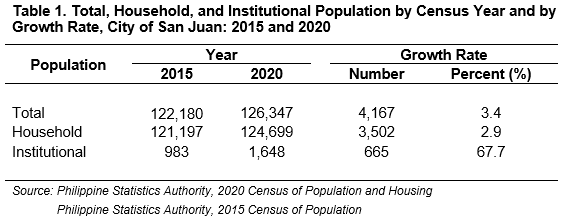
Meanwhile, in the number of household population, women (64,575) outnumbered men (60,124) by 3.6 percent or by 4,451 persons. With these figures, the sex ratio in 2020 resulted in 93 males for every 100 females. (See Table 4)
In comparison to 2015, women also outnumbered men but with a higher percentage rate than in 2020. Women exceeded the number of men by 5.0 percent or by 6,071 persons, resulting in a sex ratio of 90 males for every 100 females. (See Table 3)
Halo-halo (St. Joseph) holds the highest record for the growth rate of women and men in San Juan
Among the 21 barangays of San Juan, West Crame had the highest number of women and men wherein San Juaneñas were 8,392 and San Juaneños were 7,890. West Crame also prevailed as the barangay with the highest population back in 2015 with 16,753 persons – 8,730 were women and 8,023 were men. (See Figure 1 and Table 3 and 4)
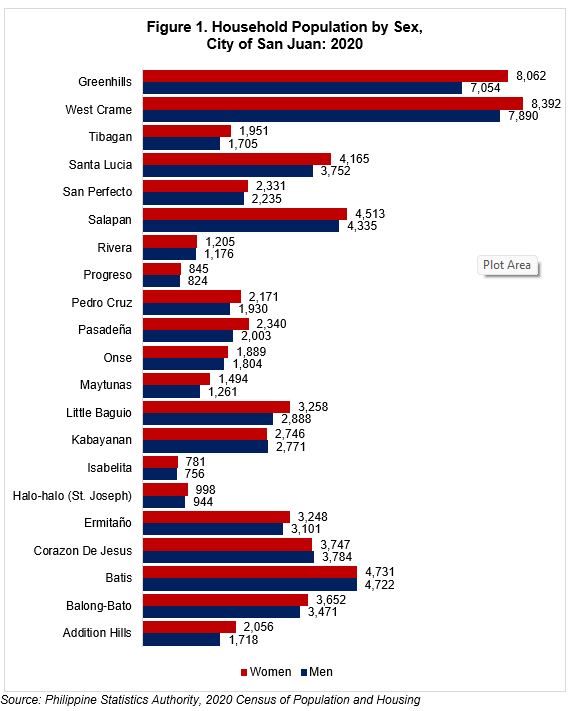
On the other hand, the barangay recorded with the lowest number of populations in 2015 was Barangay Halo-halo (St. Joseph) and in 2020 was Barangay Isabelita. Barangay Halo-halo (St. Joseph) had 383 women and 277 men in 2015 while Barangay Isabelita had 781 women and 756 men in 2020. Figure 1 also shows that despite women dominating the household population, there are still municipalities where men had a higher population than women. (See Figure 1 and Table 3 and 4)
Moreover, regardless of West Crame having the highest number of women and men, the barangay of Halo-halo (St. Joseph) recorded the highest growth rate of women and men in 2020 at 160.6 percent and 240.8 percent, respectively. (See Table 5)
The number of San Juaneñas being declared as household head is gradually increasing
There was a total of 31,519 household heads in the city as of 01 May 2020. Seven (7) out of 10 of these household heads were men (21,788) while three (3) out of 10 were women (9,731). The household head is a person who is 15 years old and over who generally provides the chief source of income for the household unit. It is an adult person, male or female, who is responsible for the organization and care of the household or who is regarded as such by the members of the household. In comparison to 2015, the household heads increased by 9.7 percent or 2,779 persons in 2020. (See Table 6)
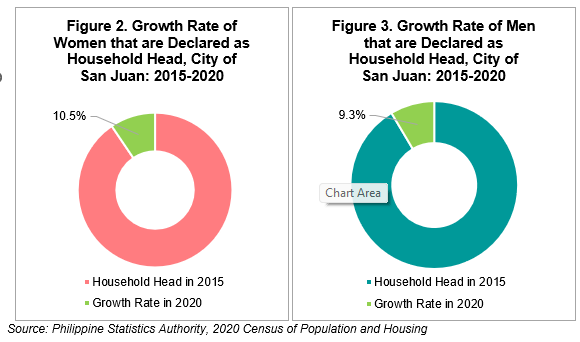
As time goes by, more males were consistently declared as the household head by their family or by their household members. However, we can also observe that the number of women who were declared as the household head were also gradually increasing. In fact, from 2015 to 2020, the number of women declared as the household head increased by 10.5 percent or by 922 persons. Meanwhile, household heads that were men increased by 9.3 percent or by 1,857 persons. (See Figure 2 and 3 and Table 6)
About 31.0 percent of the household population of San Juan are married
In 2020, nearly half (49.8% or 62,069) of the household population of San Juan were single wherein 30,861 were women and 31,208 were men. Moreover, about 31.0 percent (31.4% or 39,177) were married wherein 19,939 were women and 19,238 were men. Meanwhile, 2,007 were common-law or in a live-in set-up wherein 1,379 were women and 628 were men. On the other hand, roughly 4.0 percent (3.7% or 4,577) of the household population have been divorced, separated, or annulled wherein 3,781 were women and 796 were men. In addition, more than 16,000 (13.5% or 16,805) lost their wife or husband through death wherein 8,577 were women and 8,228 were men. However, there were 64 persons whose marital status was left unknown. (See Table 2)
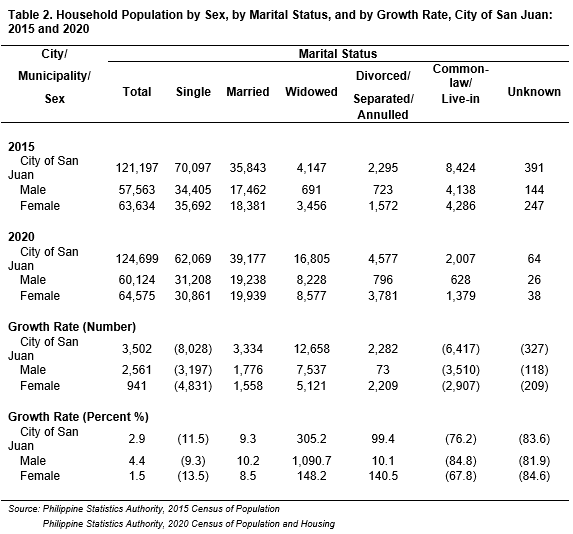
In contrast with 2015, the marital status of citizens in the city had a drastic change. The percentage of individuals who had a marital status of married, widowed, and divorced or separated raised by 9.3 percent (3,334), 305.2 percent (12,658), and 99.4 percent (2,282), respectively. On the contrary, the percentage of women and men who had a marital status of single, common-law or live-in, and unknown fell off by 11.5 percent, 76.2 percent, and 83.6 percent, respectively. (See Table 2)
The number of literate women in San Juan is 4.2 percent higher than men
About 99.0 percent (98.9% or 112,796) of the residents in San Juan ages 5 years old and over can read, write, and understand simple messages. San Juaneñas contributed approximately 52.0 percent (52.1% or 58,798) to this population, while San Juaneños contributed around 48.0 percent (47.9% or 53,998). (See Table 7)
The number of literate individuals in the city in 2020 were 2.0 percent (2,261) higher compared to the number of literate individuals in 2015. (See Table 7)
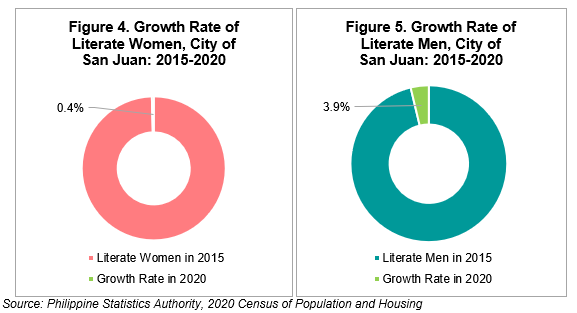
Figure 4 and 5 shows the growth rate of literate women and men in the City of San Juan from the period of 2015 to 2020. The development rate of literate men were 3.5 percent (3.9% or 2,017) higher than women (0.4% or 244). (See Figure 4 and 5 and Table 7)
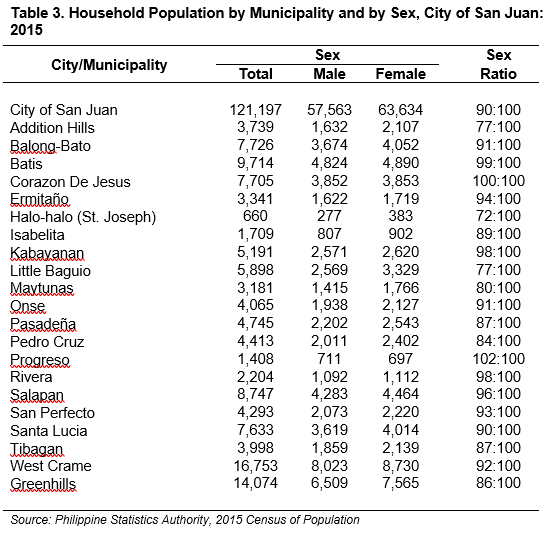
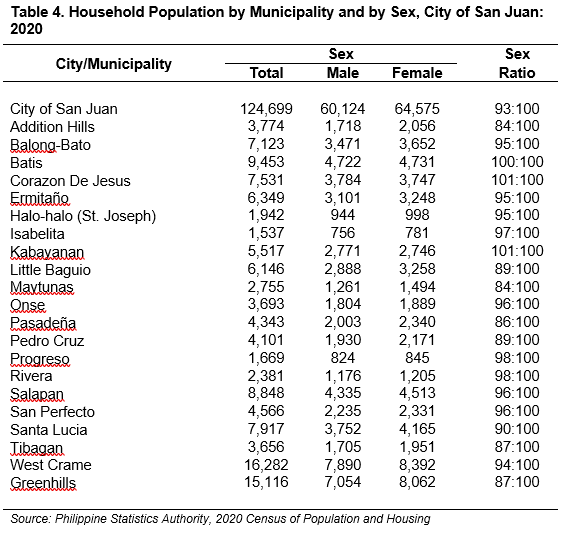
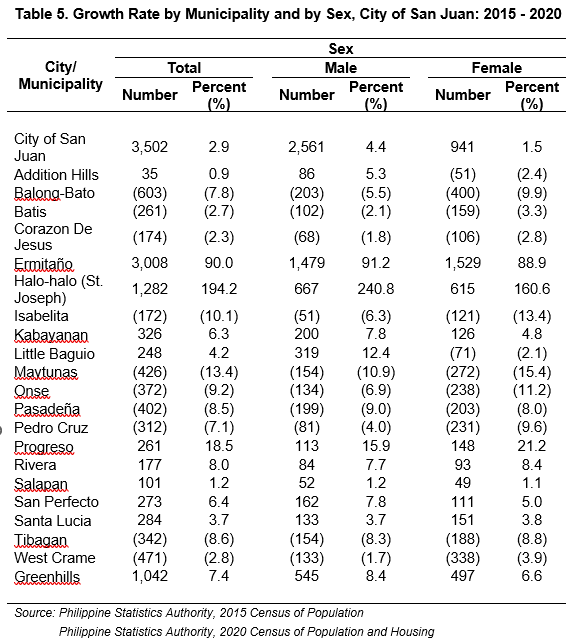
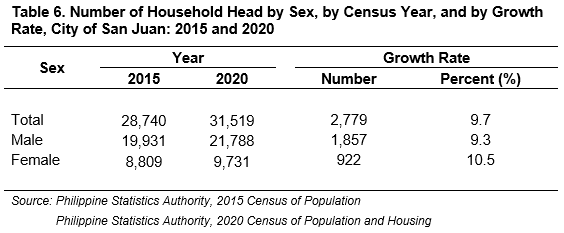
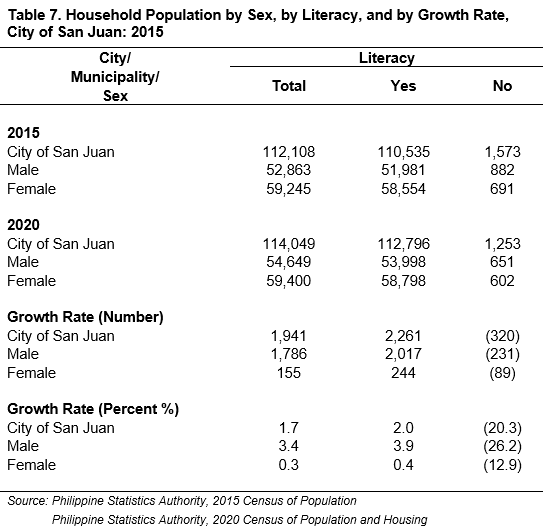
(SGD.) Amelia G. Basilio
Chief Statistical Specialist
Officer-in-Charge
